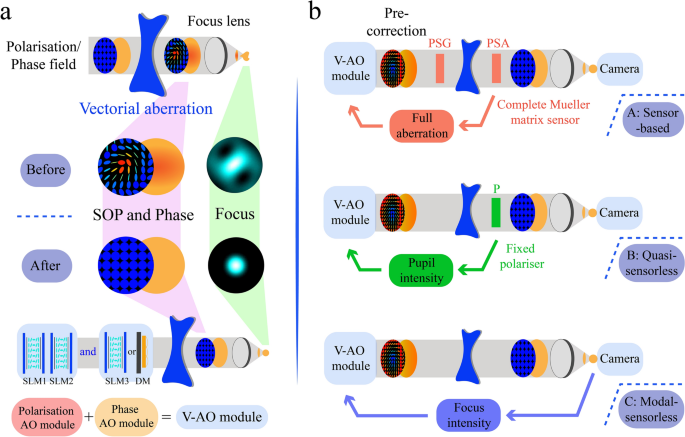Vectorial adaptive optics
IF 32.1
Q1 OPTICS
引用次数: 7
Abstract
Adaptive optics normally concerns the feedback correction of phase aberrations. Such correction has been of benefit in various optical systems, with applications ranging in scale from astronomical telescopes to super-resolution microscopes. Here we extend this powerful tool into the vectorial domain, encompassing higher-dimensional feedback correction of both polarisation and phase. This technique is termed vectorial adaptive optics (V-AO). We show that V-AO can be implemented using sensor feedback, indirectly using sensorless AO, or in hybrid form combining aspects of both. We validate improvements in both vector field state and the focal quality of an optical system, through correction for commonplace vectorial aberration sources, ranging from objective lenses to biological samples. This technique pushes the boundaries of traditional scalar beam shaping by providing feedback control of extra vectorial degrees of freedom. This paves the way for next generation AO functionality by manipulating the complex vectorial field.

矢量自适应光学
自适应光学通常涉及相位像差的反馈校正。这种校正在各种光学系统中都是有益的,应用范围从天文望远镜到超分辨率显微镜。在这里,我们将这个强大的工具扩展到向量域,包括极化和相位的高维反馈校正。这种技术被称为矢量自适应光学(V-AO)。我们表明,V-AO可以使用传感器反馈,间接使用无传感器AO,或以混合形式结合两者的各个方面来实现。我们通过校正常见的矢量像差源(从物镜到生物样品)来验证光学系统的矢量场状态和焦质量的改进。该技术通过提供额外矢量自由度的反馈控制,突破了传统标量光束整形的极限。这为通过操纵复向量场实现下一代AO功能铺平了道路。
本文章由计算机程序翻译,如有差异,请以英文原文为准。
求助全文
约1分钟内获得全文
求助全文

 求助内容:
求助内容: 应助结果提醒方式:
应助结果提醒方式:


